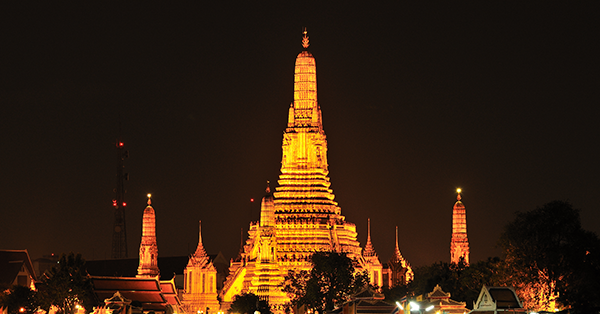
With their gilded spires, ornate roofs, and intricately carved statues of Buddha, Thailand’s temples, or wats, are a sight to see. And while no visit to the country is complete without a visit, it’s important to remember that these temples are operational houses of worship for 95 percent of the Thai population.
But don’t worry, we’ve got you covered. This is our guide to the temples of Thailand.
History
Buddhism is believed to have come to Thailand as early as 250 B.C. Fast-forward to now and there are over 33 thousand temples dedicated to the religion. Temple architecture is characterized by the slanting ornate roofs, specifically the lamyong, the decorative structure on the edge of the roof that’s often sculpted to resemble the Nāga (half-serpent, half-human deities). In many temples, you can see Hindu influences as well. All temples are divided into the Phutthawat, the area that is dedicated to Buddha, and the Sangkhawat, the monks’ living quarters.
Temples
While there is no shortage of awe-inspiring wats to choose from, each with its own unique atmosphere, here are four of our favorites.
Wat Arun
One of Bangkok’s most famous temples, Wat Arun sits on a site that has been the home of Buddhist temples since the 14th century. Characterized by its 230-foot spire, the Temple of Dawn derives its name from the Hindu god Aruna.
Wat Phra Kaew
The Temple of the Emerald Buddha is one of the most sacred wats in Thailand. According to legend, the Buddha that resides inside is thought to “bring prosperity to each country in which it resides.” While it is forbidden to take photographs of this Thai icon, it’s still an experience you’ll keep with you.
Wat Pho
Well-known for its extensive collection of Buddha statues (over a thousand!) as well as its huge Reclining Buddha statue, Wat Pho is one of the oldest temples in Bangkok. It is located right next to the Grand Palace and contains the ashes of King Rama I.
Wat Doi Suthep
Located on the Doi Suthep Mountain, legend has it that a white elephant carrying a Buddhist relic chose the spot where the temple now sits. Boasting impressive views of Chiang Mai, Wat Doi Suthep is one of the most sacred places of pilgrimage in Thailand. Fun fact: There was no road access to this centuries-old temple until 1935.
Etiquette
Here are a few tips for you and your students to follow while visiting these iconic landmarks.
Dress: As with any house of worship, it is important to dress modestly. Clothes that cover the elbows and knees are essential for temples. Temperatures in Thailand can get well above 100 degrees though, so be sure to pack clothes that are breathable and light.
Behavior: When entering a wat, remove your shoes and step over the threshold, not on it, as thresholds are thought to keep out bad spirits. While it might feel like second nature, never point at anything with your finger.
Monk chats: Don’t be surprised if a monk strikes up a conversation with you. Many monks do this to practice their English. Temples have been known to organize formal monk chats, where you can ask questions about what it is like to be a monk. Monks are forbidden to touch women, so if you are a female offering something to a monk, pass it to a male companion first.
A temple visit is a can’t-miss, once-in-a-lifetime opportunity to experience a quintessential part of the history and culture of Thailand. And with the help of this guide, you can do it worry-free.
Related articles
